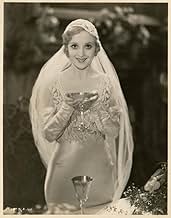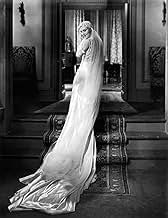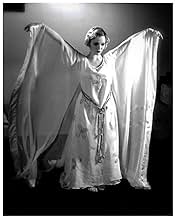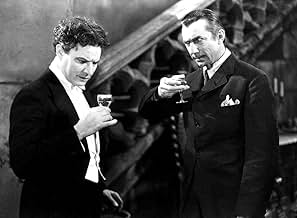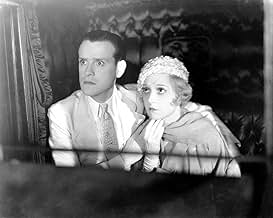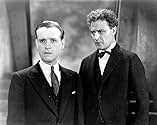NOTE IMDb
6,2/10
12 k
MA NOTE
Un jeune homme se tourne vers un sorcier pour attirer la femme qu'il aime loin de son fiancé, mais la transforme en esclave zombie.Un jeune homme se tourne vers un sorcier pour attirer la femme qu'il aime loin de son fiancé, mais la transforme en esclave zombie.Un jeune homme se tourne vers un sorcier pour attirer la femme qu'il aime loin de son fiancé, mais la transforme en esclave zombie.
- Réalisation
- Scénario
- Casting principal
John T. Prince
- Ledot - Zombie
- (as John Printz)
Clarence Muse
- Coach Driver
- (non crédité)
Avis à la une
White Zombie is beautiful to watch, a combination of gorgeous black and white photography and wonderfully rendered matte paintings, and combo shots. I found the ending somewhat underwhelming, especially in light of some foreshadowing which does not pay off. Nonetheless, a true classic, even more fascinating if viewed through the lens of more informed understandings of colonialism, slavery, and related race relations.
A couple of years ago I saw the 1931 version of Dracula as part of a live performance for the new musical score composed by Philip Glass. Even in this refined setting, the film was met by laughter from the audience during several sections. This seemed rather odd to me, but I suppose older horror films cannot help but lose some of their initial impact over time. The black and white photography and performance techniques became antiquated, hence humorous to some. As time went on, filmmakers begin to spoof the broad overacting and dramatic music of the vintage horror picture. It is impossible today to view a film like WHITE ZOMBIE and fully understand the impact it may have had in 1932. It does, however, escape (for the most part anyway) the mirthful reactions described above.
Director Victor Halprin's telling of this tale is often cited as the genesis of the "zombie picture." There is some debate about this, but WHITE ZOMBIE is certainly one of the early films to deal with the Haitian legend of "the dead that walk." The story revolves around a young couple who have traveled through Haiti to meet with their friend and benefactor Charles Beaumont (Robert Frazer), at whose villa they plan to be married. He has designs on the young bride, Madeleine (Madge Bellamy), and enlists the help of Murder Legendre (the name kind of says it all) played by Bela Lugosi. After the wedding, Legendre performs some "witchcraft" rituals and Madeleine falls into a death-like state. Believing that she has in fact died, the newly minted groom (John Harron) spirals into a drunken maelstrom, eventually seeking out the learned missionary Dr. Bruner (Joseph Cawthorn) to help solve the mystery. All paths seem to lead back to Legendre as the plot thickens and Beaumont's true motives are discovered.
It is fascinating to watch these type of films, some of which, like WHITE ZOMBIE age well with time. This is partly due to the fact that it has been largely forgotten in the wake of the more successful Universal horror flicks. The main drawn here will be the performance by Lugosi. He essentially "vamps" his role in Dracula, but manages to fashion a fairly distinct and unsettling screen presence. It would be roles like this however that would lead to his rigid typecasting; as time went on, he was all but discarded by the film industry (see ED WOOD [1994] for his later years). Halprin's direction focuses on atmosphere and gloom. He is well paired with cinematographer Arthur Martinelli and together they create a suitably shadow-laden backdrop for this macabre story. WHITE ZOMBIE is ambitious in camera angles and editing. At one point there is a diagonal wipe edit, which stops midscreen to reveal the actions of two separate characters. This type of effect is effortless to achieve now, but must have been laborious in 1932. Observe also the unusually large transitional set of the plantation interior, or the framing of Lugosi though the ornate stone work during certain shots. These small details help set WHITE ZOMBIE apart by creating a realistic environment and aid in visually representing the pathology of the characters.
Since the 30's there has been countless movies about killer zombies run amuck. The concept predominantly became fodder for B-grade schlock productions. The genre would experience something of a renaissance in 1968 with George Romero's NIGHT OF THE LIVING DEAD which created quite a stir at the time and resulted in zombies becoming, once again, fashionable. The Haitian setting of WHITE ZOMBIE would also be revisited in THE SERPENT AND THE RAINBOW (1988) and the "undead" as a means of cheap labor subtext would be exploited for darkly comedic effect in the underrated HBO film CAST A DEADLY SPELL (1991). In recent years, there has been such a boom of these "living dead" productions that it is hard to keep track of them all. WHITE ZOMBIE, as an early example of this current trend, but should be seen as more than just a footnote in the ever growing history of film. It is not a great movie, like Dracula, but will prove to be of interest to film buffs at least. It has more to offer, though, and I hope that it will continue to be rediscovered by successive generations. 7/10
Director Victor Halprin's telling of this tale is often cited as the genesis of the "zombie picture." There is some debate about this, but WHITE ZOMBIE is certainly one of the early films to deal with the Haitian legend of "the dead that walk." The story revolves around a young couple who have traveled through Haiti to meet with their friend and benefactor Charles Beaumont (Robert Frazer), at whose villa they plan to be married. He has designs on the young bride, Madeleine (Madge Bellamy), and enlists the help of Murder Legendre (the name kind of says it all) played by Bela Lugosi. After the wedding, Legendre performs some "witchcraft" rituals and Madeleine falls into a death-like state. Believing that she has in fact died, the newly minted groom (John Harron) spirals into a drunken maelstrom, eventually seeking out the learned missionary Dr. Bruner (Joseph Cawthorn) to help solve the mystery. All paths seem to lead back to Legendre as the plot thickens and Beaumont's true motives are discovered.
It is fascinating to watch these type of films, some of which, like WHITE ZOMBIE age well with time. This is partly due to the fact that it has been largely forgotten in the wake of the more successful Universal horror flicks. The main drawn here will be the performance by Lugosi. He essentially "vamps" his role in Dracula, but manages to fashion a fairly distinct and unsettling screen presence. It would be roles like this however that would lead to his rigid typecasting; as time went on, he was all but discarded by the film industry (see ED WOOD [1994] for his later years). Halprin's direction focuses on atmosphere and gloom. He is well paired with cinematographer Arthur Martinelli and together they create a suitably shadow-laden backdrop for this macabre story. WHITE ZOMBIE is ambitious in camera angles and editing. At one point there is a diagonal wipe edit, which stops midscreen to reveal the actions of two separate characters. This type of effect is effortless to achieve now, but must have been laborious in 1932. Observe also the unusually large transitional set of the plantation interior, or the framing of Lugosi though the ornate stone work during certain shots. These small details help set WHITE ZOMBIE apart by creating a realistic environment and aid in visually representing the pathology of the characters.
Since the 30's there has been countless movies about killer zombies run amuck. The concept predominantly became fodder for B-grade schlock productions. The genre would experience something of a renaissance in 1968 with George Romero's NIGHT OF THE LIVING DEAD which created quite a stir at the time and resulted in zombies becoming, once again, fashionable. The Haitian setting of WHITE ZOMBIE would also be revisited in THE SERPENT AND THE RAINBOW (1988) and the "undead" as a means of cheap labor subtext would be exploited for darkly comedic effect in the underrated HBO film CAST A DEADLY SPELL (1991). In recent years, there has been such a boom of these "living dead" productions that it is hard to keep track of them all. WHITE ZOMBIE, as an early example of this current trend, but should be seen as more than just a footnote in the ever growing history of film. It is not a great movie, like Dracula, but will prove to be of interest to film buffs at least. It has more to offer, though, and I hope that it will continue to be rediscovered by successive generations. 7/10
This review will be more about the print and theatrical experience than about the plot. Most people won't find this "useful", but hey, so what. Here's my two cents.
If you have the opportunity to see the Roan Group print projected in a theater, don't hesitate. Go see it.
I just saw this in the big screen last weekend and it is MUCH better in a proper theater with a crowd of enthusiasts than in the confines of your home, even with a big TV and 5.1. The audience I was in was comprised of about 150 kids and their parents. The kids had a great time as did I, who has seen the movie several times over the years in the washed out public domain video prints that have circulated forever.
The Roan Group print (same as the remastered DVD) is the one we saw, projected in 35 mm. It was obvious that there were two sources for this print. The vast majority of this appears to come from a very nice print with high contrast and sharp definition. The "fill-in" portions, apparently missing from the other source, are much more typical of a 75-year-old cheapie independent production shot in 11 days, i.e., scratchy, multiple generations removed from the negative, and faded. Thankfully there's not too much from that second source. There are a few jumps in the film (a few seconds at most) that could not be restored. Too bad, but no biggie.
The sound was problematic, veering from a comfortable volume when dialogue was speaking, to way too loud, almost to the point of distortion, when the music played or the bird squawked. I really don't think it was the theater's fault as their sound is always "just right".
Interestingly, for a movie this old (pre King Kong and Bride of Frankenstein) there was a whole lot of music and not as much dialogue as one usually gets in a film from this era. The music was rarely background to dialogue and was used almost exclusively to enhance the mood of the film. It was probably cheaper to do it this way, but who cares why. It works.
This is a really neat film full of great shots and creepy characters. Bela is fantastic, maybe his best performance on film. White Zombie hardly ranks up there with the Universal classics of the era, but it is positively time for a historical and critical reappraisal of this newly restored film.
It's good on video, but on the big screen, WOW!
If you have the opportunity to see the Roan Group print projected in a theater, don't hesitate. Go see it.
I just saw this in the big screen last weekend and it is MUCH better in a proper theater with a crowd of enthusiasts than in the confines of your home, even with a big TV and 5.1. The audience I was in was comprised of about 150 kids and their parents. The kids had a great time as did I, who has seen the movie several times over the years in the washed out public domain video prints that have circulated forever.
The Roan Group print (same as the remastered DVD) is the one we saw, projected in 35 mm. It was obvious that there were two sources for this print. The vast majority of this appears to come from a very nice print with high contrast and sharp definition. The "fill-in" portions, apparently missing from the other source, are much more typical of a 75-year-old cheapie independent production shot in 11 days, i.e., scratchy, multiple generations removed from the negative, and faded. Thankfully there's not too much from that second source. There are a few jumps in the film (a few seconds at most) that could not be restored. Too bad, but no biggie.
The sound was problematic, veering from a comfortable volume when dialogue was speaking, to way too loud, almost to the point of distortion, when the music played or the bird squawked. I really don't think it was the theater's fault as their sound is always "just right".
Interestingly, for a movie this old (pre King Kong and Bride of Frankenstein) there was a whole lot of music and not as much dialogue as one usually gets in a film from this era. The music was rarely background to dialogue and was used almost exclusively to enhance the mood of the film. It was probably cheaper to do it this way, but who cares why. It works.
This is a really neat film full of great shots and creepy characters. Bela is fantastic, maybe his best performance on film. White Zombie hardly ranks up there with the Universal classics of the era, but it is positively time for a historical and critical reappraisal of this newly restored film.
It's good on video, but on the big screen, WOW!
Sometimes silly, sometimes stilted, nearly always stagey, White Zombie remains nonetheless one of the most visually fascinating films in horror history. Who can forget the image of Madge Bellamy's alabaster gown flowing down the concrete staircase, or the zombie burial procession outlined spectrally against the sky, or the sinister shadows cast demonically across a dance floor. Then there's the magnificently Gothic hall with its grotesquely twisted bannister like none other I've seen. In fact, almost every scene presents at least one arresting visual feature. As good as these and the many other touches are, it's still the mill scene that remains a masterpiece of visual staging. It must be seen to be appreciated-- the pitiless grind of the crusher, the soundless shuffle circling into the maw-- all in all, one of the deeper levels of Dante's inferno and one that's bound to stay with you.
If the visuals are inspired, the acting is not. It's almost as if two different people are in charge. Bellamy is quite good with her large liquid eyes and bee-stung lips. Her transformation into a zombie stupor is well performed. Of course, there's also Lugosi as Lugosi, florid, hammy, but effective nonetheless. The other principals, however, bring down the proceedings with what can only be described as bad acting. Bellamy's swain in particular is plain annoying, while the preacher appears to have wandered in from a breezy Bing Crosby production. Too bad. With more appropriate performances this could have been an all-time classic.
As things stand, it's a truly memorable film, whose influence can be seen in such diverse venues as Val Lewton's horror cycle, Bergman's The Seventh Seal, and Romero's Night of the Living Dead. Except for the mill scene with its eerily grinding tonality, the movie might be best enjoyed by turning off the sound altogether. (P. S. Colorizing this b&w marvel is nothing less than a crime.)
If the visuals are inspired, the acting is not. It's almost as if two different people are in charge. Bellamy is quite good with her large liquid eyes and bee-stung lips. Her transformation into a zombie stupor is well performed. Of course, there's also Lugosi as Lugosi, florid, hammy, but effective nonetheless. The other principals, however, bring down the proceedings with what can only be described as bad acting. Bellamy's swain in particular is plain annoying, while the preacher appears to have wandered in from a breezy Bing Crosby production. Too bad. With more appropriate performances this could have been an all-time classic.
As things stand, it's a truly memorable film, whose influence can be seen in such diverse venues as Val Lewton's horror cycle, Bergman's The Seventh Seal, and Romero's Night of the Living Dead. Except for the mill scene with its eerily grinding tonality, the movie might be best enjoyed by turning off the sound altogether. (P. S. Colorizing this b&w marvel is nothing less than a crime.)
You have to change your way of looking at movies to really enjoy old horror movies like this one. Don't be in a rush to see action, violence and don't expect to see any bloodshed at all. Most of the grisly part is implied and you have to fill in the details. Instead, watch it for the scenery, the acting and the plot.
I prefer the older horror films to the newer, slash-fest movies because they allow me to think and they generally have a good, moral theme. You never have a good guy as a demon or a fiend, for instance.
White Zombie has the older, traditional zombie characters that are not evil in themselves. Instead, they are mindless and controlled by a shaman, who is generally evil and must be destroyed to set the zombies, who are victims, free. In the newer Zombie movies like Night of the Living Dead, the Zombies are either not controlled or are evil themselves and must be destroyed.
I think the acting by the zombies is very good and so is their make-up (i.e. they have very frightening faces.) Their master, played by Bela Lugosi, is also played masterfully. The missionary is also good, but most of the rest of the cast is only average.
It's a fun movie to watch and I gave it a score of 7 out of 10. If you love early horror movies, buy it. Don't pay more than $10 unless it's packaged with other movies because the picture and the sound quality are weak. If not, you might catch it on a Friday night horror fest on TV. It's worth the time watching it if for Bela Lugosi alone.
I prefer the older horror films to the newer, slash-fest movies because they allow me to think and they generally have a good, moral theme. You never have a good guy as a demon or a fiend, for instance.
White Zombie has the older, traditional zombie characters that are not evil in themselves. Instead, they are mindless and controlled by a shaman, who is generally evil and must be destroyed to set the zombies, who are victims, free. In the newer Zombie movies like Night of the Living Dead, the Zombies are either not controlled or are evil themselves and must be destroyed.
I think the acting by the zombies is very good and so is their make-up (i.e. they have very frightening faces.) Their master, played by Bela Lugosi, is also played masterfully. The missionary is also good, but most of the rest of the cast is only average.
It's a fun movie to watch and I gave it a score of 7 out of 10. If you love early horror movies, buy it. Don't pay more than $10 unless it's packaged with other movies because the picture and the sound quality are weak. If not, you might catch it on a Friday night horror fest on TV. It's worth the time watching it if for Bela Lugosi alone.
Le saviez-vous
- AnecdotesWas a personal favorite of Bela Lugosi, according to his son, Bela Lugosi Jr..
- Gaffes(at around 46 mins) The vulture manages to scream, loudly and repeatedly, with its beak shut.
- Citations
Madeline: Driver, who were those men we saw?
Coach Driver: They are not men, madame. They are dead bodies!
- Crédits fous"White Zombie starring Bela (Dracula) Lugosi."
- Versions alternativesThe scene is which the zombie is crushed by the grinder, after falling into the chute in the factory, is missing from most available prints.
- ConnexionsEdited into Revolt of the Zombies (1936)
- Bandes originalesBridal Chorus (Here Comes the Bride)
(uncredited)
from "Lohengrin"
Music by Richard Wagner (1850)
Played on an organ for the wedding
Meilleurs choix
Connectez-vous pour évaluer et suivre la liste de favoris afin de recevoir des recommandations personnalisées
- How long is White Zombie?Alimenté par Alexa
Détails
- Date de sortie
- Pays d’origine
- Langue
- Aussi connu sous le nom de
- White Zombie
- Lieux de tournage
- Société de production
- Voir plus de crédits d'entreprise sur IMDbPro
Box-office
- Budget
- 50 000 $US (estimé)
- Durée1 heure 9 minutes
- Couleur
- Rapport de forme
- 1.37 : 1
Contribuer à cette page
Suggérer une modification ou ajouter du contenu manquant

Lacune principale
By what name was Les Morts-vivants (1932) officially released in India in English?
Répondre



